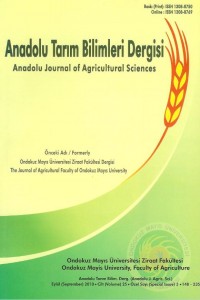HYDRAULIC CONDUCTIVITY AT AND NEAR SATURATION OF AN ORTHIC LUVISOL AFTER 15 YEARS OF DIFFERENT SOIL MANAGEMENT PRACTICES
Öz
Soil tillage is one of the key soil management practices in agricultural land use. The farming concepts are based on understanding of soil physical and hydrological characteristics under different tillage treatments. Hydraulic conductivity of the surface layer determines water infiltration into the soil profile and possible runoff formation. The treatment of the surface layer affects the soil pore system (distribution and connectivity of macroscopic cracks, voids, holes, etc.). The aim of this study was to evaluate the changes in hydraulic conductivity at and near saturation under the field conditions for soil with different tillage treatments (reduced tillage – RT, no tillage – NT, and conventional tillage – CT). The field experiments were carried out in four phases (June 2008, September 2008, April 2009, and July 2009) in order to characterise also the seasonal changes in hydraulic conductivity of the soil. Pressure ring infiltrometer (Matula and Kozáková, 1997) was employed to carry out the infiltration tests to determine hydraulic conductivity at saturation, Ks. The infiltration time was allowed long enough to obtain steady state infiltration data, which were analysed based on the equations formulated by Philip (1985) and Reynolds and Elrick (1990). To determine hydraulic conductivity near saturation K(h), Mini Disk infiltrometer (Decagon Devices, Inc.) was used. The transient infiltration data obtained from Mini Disk infiltrometer were analysed by HYDRUS 2D software (Šimůnek et al., 1999). Analysis of variance identified significantly lower Ks values for NT plots, while CT and RT plots did not differ from each other. When comparing the K(h) values measured at three consecutive water pressure heads (-5, -3, and -1 cm) the statistically significant differences were found between all three treatments (CT > RT > NT). The seasonal changes in hydraulic conductivity were reflecting the changes in structure of the surface layer (caused for example by tillage operation, winter frost, and wetting and drying circles). In contrast to some published studies, this study showed no improvement in soil structure of soil under NT after certain time period, resulting in significantly lower values of hydraulic conductivity during each of the experimental phase.
Öz
Ayrıntılar
| Birincil Dil | İngilizce |
|---|---|
| Bölüm | Toprak Bilimi ve Bitki Besleme |
| Yazarlar | |
| Yayımlanma Tarihi | 20 Ağustos 2010 |
| Yayımlandığı Sayı | Yıl 2010 Cilt: 25 Sayı: 3 |


